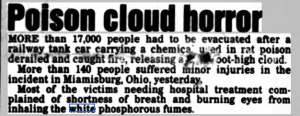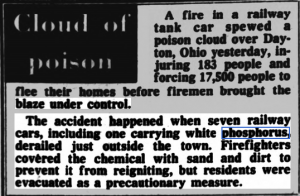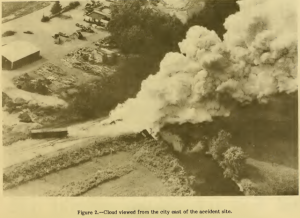There are very few documented cases of the environmental release of white phosphorus on a large scale, (apart from its misuse in war….oh sorry “smokescreening”), but one such instance occurred in Ohio in the US in 1986, and yes you guessed it, it involved Albright and Wilson. This shipment was en route from their Varennes plant in Quebec Canada (under the ERCO brand), to one of their factories in the state.
I have found a couple of brief press clips of this from firstly The Reading Evening Post of 9th July 1986.
I’m glad the paper correctly identifies one of the uses of this “poisonous” chemical, rather than that which the Boss Hogg spinners at Albright and Wilson would claim as to how this building block would produce “everyday chemicals” . P4 will never be an “everyday chemical” because its manufacture is unnatural and it cannot exist naturally in the elemental form. The injuries described are obvious classic symptoms of the release of phosphorus pentoxide and phosphoric acid- the breakdown products of P4, but in this case the train also contained sulphur and other chemicals!
The Dundee Courier dated 10th July 1986 adds a few more to the injured list, and sheds a little light on how the resulting release of phosphorus pentoxide and vapour was tackled by the emergency services.
This must have been a literal nightmare for residents as well as the first responders, and shows the dangers of carrying this chemical by these means and how injuries were sustained, when reportedly the tank exploded. Thankfully no one was killed.

It is clear that events not on this scale, but still notable, occurred at Trinity Street by the use of the private rail line into the works there to transport white phosphorus, and I will be detailing these events soon in other posts. No doubt residents in the vicinity had a very lucky escape, and events would have been covered up by a company whose managers had their bonuses linked to fewer reports of environmental emissions and accidents- as the 1997 EA audit of the factory revealed.
I have managed to obtain the official US Government investigation into this 1986 accident, and at 100 pages long it is quite a read, but there are some interesting observations regards what happened and the carrying of this poison by rail. The number of people that had to be evacuated is even more than that stated in the British newspaper titles after complications of the incident revealed themselves after another 48 hours after the derailment.
HAZARDOUS MATERIALS RELEASE FOLLOWING THE DERAILMENT OF BALTIMORE AND OHIO RAILROAD COMPANY TRAIN
“Qn July 8, 1986, 15 cars of a southbound Baltimore and Ohio Railroad Company freight train derailed while traveling at 45 mph near Miamisburg, Ohio. Three of the 15 derailed cars were tank cars containing yellow phosphorus, molten sulfur, and tallow. While derailing on a bridge, these tank cars were extensively damaged, lost product, and were involved in the resulting fire. Approximately 7,000 residents from a section of Miamisburg were initially evacuated as a safety precaution. On the following day as a wreckage-clearing crew was preparing to remove the smoldering phosphorus tank car, a concrete structure supporting the tank car collapsed, and several hundred gallons of molten phosphorus inside the tank car escaped and ignited, resulting in an extensive cloud of phosphorus combustion effluents.
During the following 48 hours, a 3-square-mile area of Montgomery County, Ohio, was evacuated, forcing an estimated 30,000 people to leave their homes and businesses; 569 persons were treated for various complaints during the incident. Total property damage was $3,540,000 including the cost of hazardous materials. The National Transportation Safety Board determines that the probable cause of the uncontrollable release of phosphorus was the failure of the unprotected bottom brake support attachment during the derailment resulting in the tearing of the tank shell. Contributing to the rupture of the tank was the Federal Railroad Administration’s failure to require retroactively that reinforcement pads be installed between tank shells and welded attachments.”
“To minimize environmental pollution, the area of Bear Creek between the bridge and the Great Miami River was isolated by a barrier dam from July 9 through July 11 and diverted to the north around an area adjacent to the derailment. Approximately 200,000 gallons of water per day were treated for several weeks with hydrogen peroxide to neutralize the phosphorus. The water was then filtered through a sandbed before being discharged to the municipal sewage treatment facility. In addition to water treatment, the contaminated soils from the creekbed and railbed were excavated to a depth of 12 to 13 feet. The contaminated soils were placed on an asphalt pad to aerate and mix with hydrogen peroxide. After the soils were treated, they were disposed of at a landfill. Approximately 5,000 cubic yards of contaminated soil were removed over 2 months.”
Two of the conclusions in the episode were
“4. Toxic combustion effluents which threatened public safety generated by the burning phosphorus and sulfur were not recognized by all available emergency response guides.
5. While the molten liquid form of the products involved in this derailment served to facilitate their loading and unloading, its liquid form contributed to the spill size and amount of product released.”
The evidence of how this environmental disaster was dealt with in the US is quite interesting, and shows how the US policy of control and contain is way superior to the useless dilute and disperse of the UK Environment Agency- which always leads to greater environmental damage over larger areas . A further source
states of the clean up;
“Three lagoons (700 x 100 m total area) were constructed to isolate the contaminated stream. While most of the contaminated sediment was removed and treated by exposing the sediment on an open-air pad, the sediments that could not be removed were oxidized with two treatments of 15,000 L of 8-10% hydrogen peroxide. The hydrogen peroxide was injected into subsurface sediments with a high-pressure spray system. The initial WP concentration was as high as 4500 μg/g. Ten days after the first treatment, the concentration was reduced to 300 μg/g. Fifteen days following the second treatment, concentrations were less than 100 μg/g, and one year later, the concentrations were less than 4.4 μg/g, or a 99.9% reduction from the original concentrations. No further monitoring was reported.”
Clearly hydrogen peroxide is a very dangerous and explosive chemical to use, and must have been justified as a risk to mitigate for the even greater one that the release of this highly toxic poison along with sulphur would have caused if left unoxidized, both to people and the wider environment.
The study also considered the effects of “clean up” concerning the Albright and Wilson disaster at Placentia Bay via the Long Harbour factory.
“These case studies show that WP in aqueous media is not reduced to undetectable concentrations by simple techniques such as aeration.”
What a pity that so many in this company and the idiots controlling the regulation of a certain site in Tividale could not recognise this.
It is amazing that Albright and Wilson and the authorities could work so quickly in dealing with white phosphorus contamination in the environment , yet allow their waste disposal ponds in others to sit there in a festering shit “aeration” poison pile for decades, until such time as they could be bothered to “clean ” it up- but only then with the fraud of covering it up with a geotextile membrane and sand.




